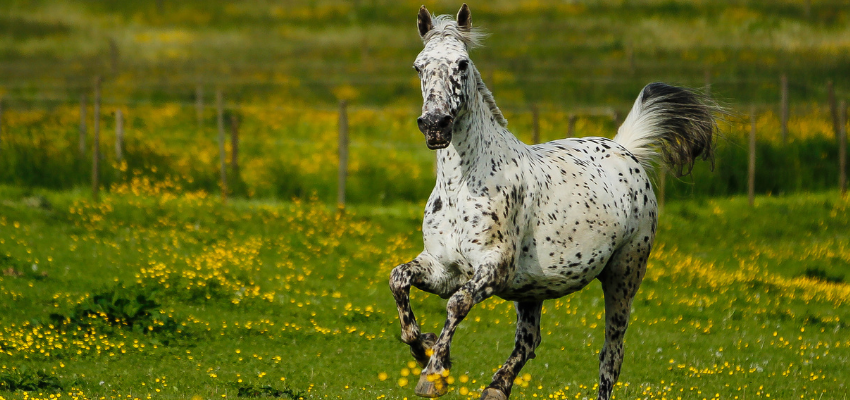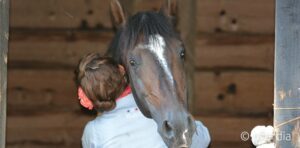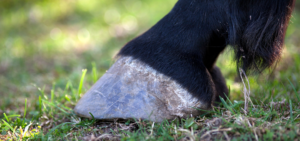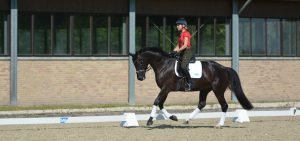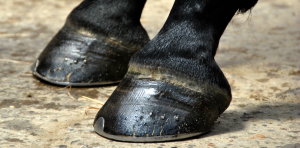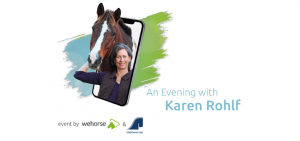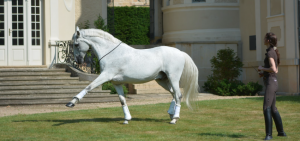The Knabstrupper is considered Denmark’s oldest horse breed and is known for its striking leopard-spotted coat. In this article, you will learn everything about the history, origin, appearance, personality, average lifespan, breed-specific health issues, care, price, and suitable disciplines of this horse breed. Enjoy reading!
Knabstrupper at a Glance
In this profile, you’ll find all the essential information about the Knabstrupper:
| Characteristic | Information |
| Height | 150 – 160 cm |
| Weight | 500 – 650 kg |
| Lifespan | 25 – 30 years |
| Coat Colors | Leopard-spotted |
| Personality | Friendly, open-minded, intelligent, willing to work, sensitive |
| Gaits | Walk, trot, canter Light-footed, expansive |
| Suitable | Sports Dressage, Jumping, Leisure |
History and Origin
The Knabstrupper originates from Denmark. It descended from the Frederiksborgers and represents a color variant of this horse breed, the leopard-spotted pattern. The royal stud farm established in Frederiksborg in 1536 bred Frederiksborger horses. Breeders crossed them with horses directly imported from Spain or those of Spanish bloodlines. Trainers raised these horses to the highest standards, and they served as exceptional warhorses.
In addition to the grand royal Frederiksborg stud, there were also private breeders who purchased horses from the royal stud, including Major Villars Lunn. He began selective breeding for the leopard-spotted pattern at the Knabstrup stud. Unfortunately, this breeding effort came to a tragic end in 1891 when many horses perished in a fire. In 1952, breeders rebuilt the stud using existing horses. Then, in 1972, enthusiasts in Denmark founded a breed association for Knabstruppers
What Does a Knabstrupper Look Like?
With the Knabstrupper, you can distinguish between two breeding directions: the Baroque and the Sport types:
- Baroque-Type: The Baroque-Type has a compact and powerful build. It possesses a short, well-muscled back, a robust, high-set neck, a strong hind end, and a slightly sloping croup. Additionally, it has a convex (Roman-nosed) head, with relatively small ears and large nostrils.
- Sport-Type: The modern Sport-Type arises from the introduction of outside bloodlines and aligns with the breeding goal of a contemporary sport horse.
However, the breeding community does not recognize the modern Sport-Type as a purebred Knabstrupper. Only a Baroque-Type Knabstrupper, bred for three generations without outside bloodlines, is considered purebred. In special cases, horses crossed with PREs, Lusitanos, or other selected Spanish horse breeds are still included in the Baroque breeding register.
Coat Colors
The appearance of a Knabstrupper is primarily characterized by its leopard-spotted coat, a color variant of the Danish Frederiksborger. You can differentiate between five color variations:
- Full Leopard: The base coat of the Full Leopard is white, with black or brown spots scattered across the entire body.
- White-born: A White-born, as the name suggests, is entirely white.
- Blanket Leopard: A Blanket Leopard has a dark coat, with white areas featuring dark spots on the back and croup.
- Snowflake Leopard: A Snowflake Leopard has a dark base coat, with white spots distributed all over the body.
- Solid: In a horse with this color, the leopard-spotted genetics are present but not expressed. It can be a solid brown to black.
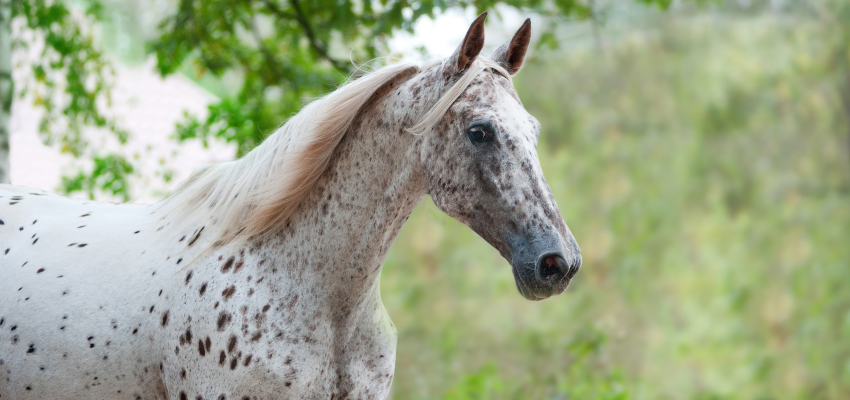
Character and Temperament
The Knabstrupper is not only popular for its unique appearance but also for its distinct character. Here you will find some character traits that distinguish this horse breed:
- Friendliness: A Knabstrupper is naturally very friendly, person-oriented, and loyal. Also, he tends to form a close bond with his owner and appreciates human company.
- Open-mindedness: This horse breed is known for its openness and curiosity. It approaches new situations or environments with bravery and is keen to explore them.
- Intelligence: The Knabstrupper is very intelligent. He is smart, attentive, learns quickly, and always focused when working.
- Work Ethic: Horses of this breed often demonstrate a high willingness to work. Further, they are motivated, eager to please, and readily take on tasks.
- Sensitivity: A Knabstrupper can be quite sensitive. Therefore, he requires a gentle, patient, and understanding approach.
- Balanced Temperament: The Knabstrupper exhibits a balanced and calm temperament, remaining unflustered and composed even in stressful situations.
Is a Knabstrupper suitable for children and beginners?
A Knabstrupper can be very sensitive and has certain expectations of his rider. For that reason, he requires an experienced rider who understands how to interpret the horse’s behavior and handle its sensitivity. Therefore, he may not be suitable for children and beginners.
How old does a Knabstrupper get?
The average lifespan of a Knabstrupper is between 25 to 30 years.
Breed-specific Diseases
While the Knabstrupper is generally a robust horse breed, like all horse breeds, it can be predisposed to certain breed-specific diseases:
Periodic Eye Inflammation
A Knabstrupper often has what’s known as a “human eye”, which is characterized by a white-bordered pupil. Consequently, this distinctive feature makes his eye susceptible to periodic inflammation. As a result, the horse may suffer from a chronic disease that occurs in flare-ups, potentially leading to blindness if not managed carefully.
Sunburn
Horses, just like humans, can get a sunburn. Especially light-colored horses are particularly sensitive to sun exposure. This is because the skin in the light areas is pink, lacking the pigments that usually protect against the sun. Especially around the mouth and nostrils, the skin is very thin, making it more prone to sunburn.
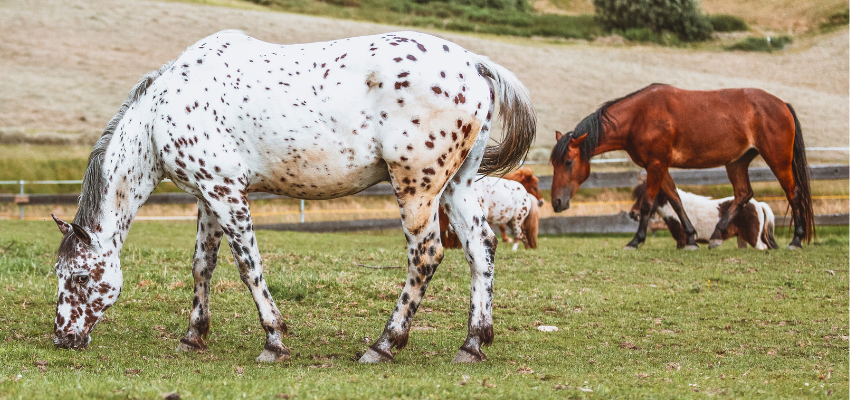
Appropriate Housing
A Knabstrupper has minimal requirements when it comes to housing. Since horses are creatures of the steppes, accustomed to walking all day long, you should ensure he has ample space to move around. Therefore you can house him in an open stable that’s as mud-free as possible with a shelter to protect him from extreme weather conditions. Alternatively, you can keep him in a box stall with daily, extended access to a large paddock or pasture. Additionally, a Knabstrupper is very social and gregarious, requiring contact with other horses.
Proper Feeding
Typically, the Knabstrupper is a breed that doesn’t need much feed. He’s getting by with very little and basic sustenance, making him an extremely efficient forager. You should keep this in mind when feeding him. Thus, ensure he gets an ample amount of roughage in the form of high-quality hay or haylage. If your horse needs concentrated feed, adjust the quantity according to your horse’s energy requirements. If you’re uncertain whether your horse requires mineral feed, which kind and how much, your veterinarian or a feed consultant can provide guidance.
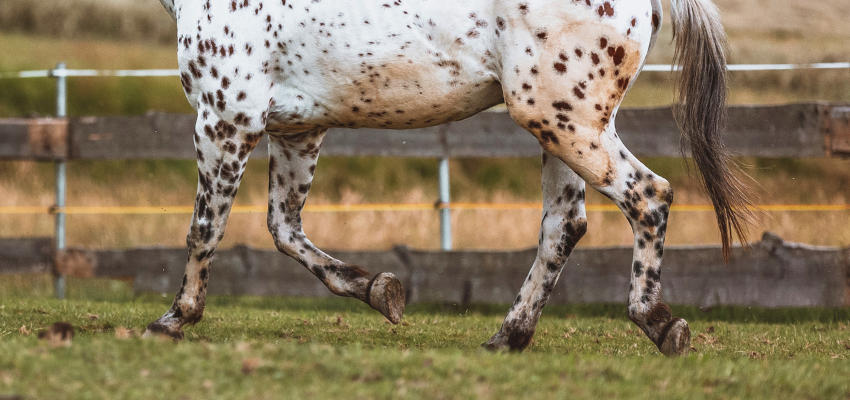
Gaits
The Knabstrupper possesses the gaits of walk, trot, and canter, and its movements are notably light-footed and expansive. This breed’s gaits are fluid, demonstrating a graceful coordination that is both effortless and striking in appearance.
For which disciplines is a Knabstrupper suitable?
The Knabstrupper is intelligent, enjoys collection, and displays expansive movements. Therefore, it is primarily suitable for classical, baroque dressage up to the high school level. Here you will find numerous exercises and tips for dressage riding from selected trainers. Due to its love for movement, agility, and nimbleness, the Knabstrupper is also commonly found in jumping or eventing. However, it is also very popular as a leisure horse.
How much does a Knabstrupper cost?
The price for a Knabstrupper can vary depending on age, level of training, lineage, and of course health condition. Therefore you can expect prices ranging between $5,000 and $15,000.
Our Conclusion
Due to its robust and athletic appearance, its friendly, eager-to-work, sensitive character, and its balanced temperament, the Knabstrupper serves as a versatile partner for dressage, jumping, eventing, and leisure activities.

